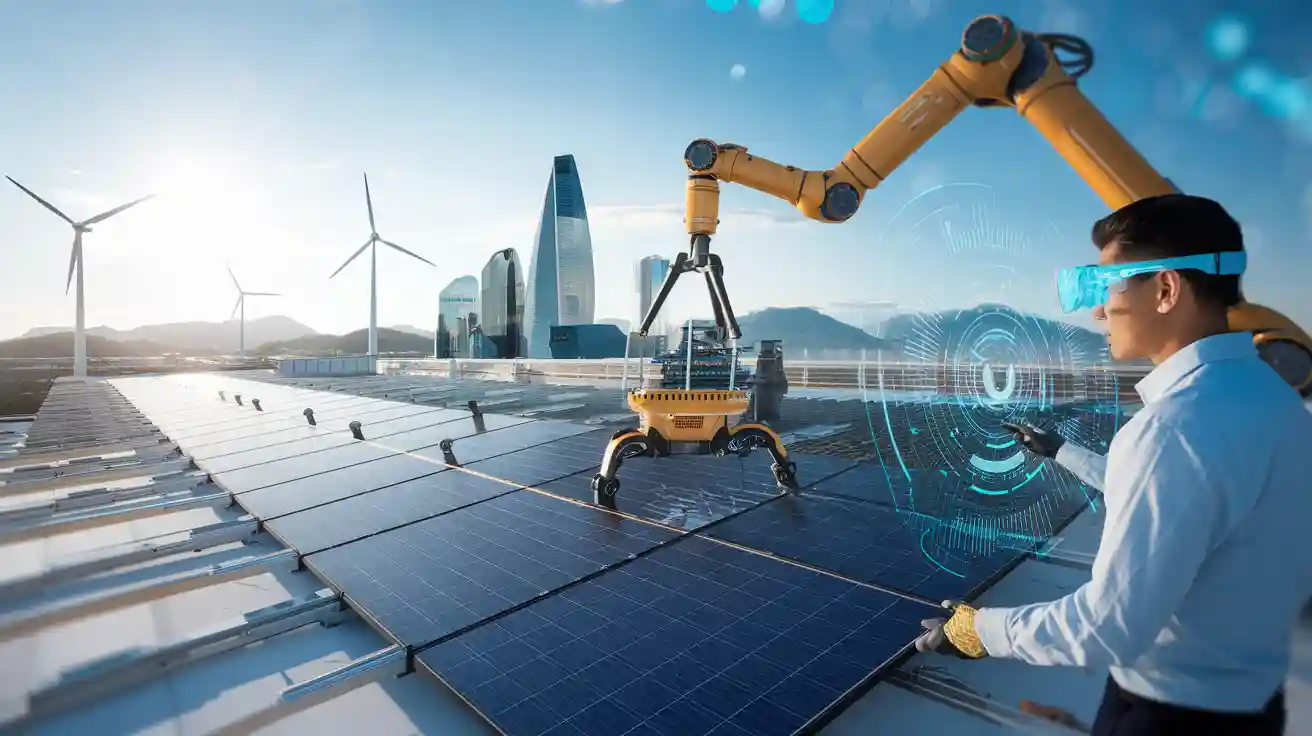Revolutionary Changes in Solar System Installation in 2025

Imagine a world where clean energy powers your daily life. In 2025, solar power is at the forefront of this significant transformation. It provides a smart and eco-friendly path forward. Innovative methods for solar system installation make it incredibly easy. These advancements deliver more affordable and efficient energy to your home. They also reshape your perspective on energy consumption. Whether for your house or larger projects, solar offers numerous options. The future of energy is here, and it’s shining brightly with home services that support this transition.
Key Takeaways
Perovskite solar cells work better and cost less than silicon panels. They make more energy using fewer panels.
Bifacial solar panels collect sunlight from both sides. This boosts energy by 25-30%, great for snowy or shiny places.
Building-Integrated Photovoltaics (BIPVs) mix energy-making with cool building designs. They cut building costs and may get tax breaks.
Floating solar farms sit on water, keeping panels cool and saving land. Solar carports give shade and make clean energy in cities.
Third-party ownership plans help people get solar power without paying upfront. Families can enjoy solar energy without big costs.
Advancements in Solar Panel Technology
Perovskite Solar Cells
Perovskite solar cells are changing how solar panels work. These cells are more efficient and cheaper than regular silicon panels. For example, perovskite/silicon tandem cells reach 34% efficiency. Regular silicon panels only reach 27%. Even standalone perovskite cells perform better at 21.1%, compared to silicon’s 17%.
This means you can make more energy with fewer panels. It saves space and lowers costs. Perovskite cells are light and bendable, making them simple to set up. They might even replace silicon panels, changing how we see solar energy systems.
Technology Type | Efficiency Rate |
|---|---|
Perovskite/Silicon | 34% |
Traditional Silicon | 27% |
Perovskite (PVP) | 21.1% |
Traditional Silicon | 17% |
Bifacial Solar Panels
Bifacial solar panels are a big step forward. Unlike regular panels, they collect sunlight from both sides. They also use light reflected off surfaces like snow or water. This design increases energy production by 25-30%.
These panels work great in snowy places or near water. They keep producing energy even after snowfall. This makes them very dependable. With bifacial panels, you can make more energy without needing extra space.
Bifacial panels boost energy by 25-30%.
They use reflected light for 10-15% more energy.
They work best in snowy or reflective areas.
Building-Integrated Photovoltaics (BIPVs)
In cities, BIPVs are changing how buildings make energy. These systems fit into windows, roofs, or walls. They create solar energy while looking stylish.
BIPVs combine energy production with building design. They save money and help the environment. Governments often give tax breaks for using them. Unlike regular panels, BIPVs don’t need extra structures, cutting building costs.
Aspect | BIPVs | Traditional Solar Panels |
|---|---|---|
Functionality | Works as building material and energy source | Needs extra building structures |
Cost Efficiency | Saves on construction costs | Costs more with added materials |
Tax Incentives | Often gets big tax credits | Depends on installation |
Tip: If you’re building something new, think about BIPVs. They mix style, energy, and sustainability.
Innovative Solar System Installation Methods
Floating Solar Farms
Floating solar farms are changing how solar panels are installed. These systems use water areas like lakes or reservoirs for panels. This saves land for farming or other important uses.
Floating solar farms work better because water keeps them cool.
They don’t need land, making them eco-friendly and practical.
Water helps increase energy production, giving better returns.
But there are some challenges. Workers need training to use boats safely. They must wear life vests for safety. Water and electricity together can cause shocks. Even with these issues, floating solar farms are a smart step for clean energy.
Solar Carports
Solar carports are a great idea for cities. They give shade to cars and make clean energy at the same time. By using parking lots, they save space and are very efficient.
Solar carports cut carbon emissions and help the environment.
They keep cities cooler and make urban areas look better.
Businesses can get money benefits and steady electricity costs.
Picture parking your car under a cool, energy-making roof. It keeps your car safe from heat and helps the planet. Solar carports are useful and stylish for today’s cities.
Agrivoltaics
Agrivoltaics mixes farming with solar energy, helping both farmers and nature. Solar panels are placed above crops, making the land more useful.
These systems keep soil moist and save water by giving shade.
Farmers earn extra money, which helps grow their businesses.
Research shows they lower carbon emissions, especially on grasslands.
Environmental Benefit | Description |
|---|---|
Lower Carbon Emissions | Reduces carbon, especially in grassy areas. |
Better Soil Moisture | Helps crops grow and cuts down on watering. |
Less Water Use | Saves water, making farming more eco-friendly. |
Agrivoltaics is more than just farming. It shows how solar energy can work with nature. This creates a greener future for everyone.
Integration of Energy Storage and Smart Systems
Advanced Energy Storage Systems
Energy storage is changing how we use solar power. Batteries like lithium-ion and flow batteries lead this change. Lithium-ion batteries store lots of energy and charge quickly. Flow batteries are great for storing energy for long periods. They work well for big solar energy setups.
Battery Type | Key Features | Best Use for Solar Energy |
|---|---|---|
Lithium-ion | Stores lots of energy, charges fast, lasts long | Popular for cars and large energy systems |
Vanadium flow | Uses liquid to store energy, holds a lot | Perfect for long-term energy storage |
Sodium-ion | Cheap, safe, but stores less energy | Good for fixed energy storage |
Solid-state | Safer, charges fast, stores more energy | Promising for future uses |
These batteries help homes and businesses stay powered during outages. They also balance energy use, making the grid more stable. With these systems, you can use solar energy even at night or on cloudy days.
Smart Inverters
Smart inverters make solar energy systems better. They keep working during small grid problems. They adjust energy output to keep voltage steady.
Keep running during small grid issues.
Adjust energy levels to stabilize the grid.
Let you check system performance anytime.
Change power output automatically when needed.
You can track your solar power system from anywhere. This helps you see how much energy you’re making and using. Smart inverters ensure your system works its best, giving you confidence.
AI and IoT in Solar Energy
AI and IoT are improving solar energy systems. AI studies weather and location data to boost energy production. It changes panel angles to capture more sunlight.
IoT uses sensors to watch system performance all the time. It spots problems early, so repairs are faster and cheaper. This reduces downtime and helps equipment last longer.
Tip: Use AI and IoT to make your solar power system smarter. These tools make managing solar energy simple and effective.
Solar Energy Trends Shaping the Market
Rise of Third-Party Ownership (TPO)
Third-party ownership (TPO) models are changing the solar industry. These include solar leases and power purchase agreements (PPAs). They remove the need to pay upfront costs. You can use solar energy without buying a system. Instead, you pay for energy at lower rates than your utility. This makes it easier for families to use solar power.
The TPO market is growing fast.
The global solar lease market may grow from $14.84 billion in 2023 to $49.26 billion by 2030.
It is expected to grow at a rate of 18.7% annually.
In the past, customer-owned systems were more common, but TPO is catching up.
This trend shows solar energy is becoming more affordable. It helps more people join the solar movement.
Blockchain for Peer-to-Peer Energy Trading
Blockchain is changing how we use solar energy. It allows people to trade energy directly with each other. This creates markets where you can buy or sell energy easily. Benefits include:
Transparency: Everyone sees the same transaction details, building trust.
Efficiency: Automated systems save time and cut costs.
Cost Reduction: No middlemen mean lower expenses for you.
Consumer Choice: Pick energy sources based on live prices.
Blockchain gives you control over your energy needs. It reduces dependence on traditional utility companies.
Impact of Government Policies
Government rules are shaping solar energy trends. Incentives like grants, subsidies, and loans make solar cheaper. Programs like the Investment Tax Credit (ITC) lower costs further. State-level incentives also encourage solar adoption.
Net metering lets you sell extra electricity back to the grid. This earns you money and supports clean energy. Stricter carbon rules push companies to create better solar products. These policies make switching to solar easier and support a greener future.
New solar tech, like bifacial panels and building-integrated photovoltaics, is changing how we use solar energy. Creative setups, such as floating solar farms and agrivoltaics, show solar can work in many places while saving resources. These improvements, along with better energy storage and tracking tools, make solar energy easier to use and more effective.
By 2025, solar energy will help meet global energy goals. Over 1,000 GW of projects are waiting for approval. Companies are also investing more in solar power. These changes make the future of solar energy exciting. They help you choose cleaner energy and prove sustainable power is possible today.
🌟 Takeaway: Solar technology offers hope for a greener future. You can join this energy revolution.
FAQ
Why is solar energy a smart choice for homes?
Solar energy cuts your electricity bills and helps the environment. It’s renewable, so it won’t run out. Today’s solar systems are cheaper and work better. Switching to solar saves money and protects the Earth.
How do floating solar farms help nature?
Floating solar farms save land for farming or other uses. Water keeps panels cool, making more energy. They lower the impact of land-based setups. This method is both smart and eco-friendly.
Can solar energy work at night?
Yes, it can! Special batteries store extra solar energy from the day. You can use this stored energy at night or when it’s cloudy. These systems give you power anytime you need it.
Are solar panels hard to take care of?
No, they’re easy to maintain. Clean them a few times yearly to keep them working well. Smart systems can check for problems and alert you. This makes caring for solar panels simple and easy.
How do governments help people use solar energy?
Governments give tax breaks, grants, and subsidies to lower costs. Programs like net metering let you sell extra energy for money. These policies make solar energy affordable and support a cleaner planet.
🌟 Tip: Look into solar energy now. Every small step helps the Earth.
See Also
Innovative Roofing Styles for Contemporary Residences
Why Consistent Garage Door Care Matters This Year
Essential Pool Care Strategies for This Year
